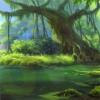UV mapping in maya 5.0, getting passed the hypershade.
i can do a planar map on a face.
i can bring up the hypershade window.
i select a texture that came with maya.
now what???
the uv text editor doesnt show anything new.
also, what button shows the texture in model view? is it 5, 6, or 7?
need help please.
so I tried to post a reply to you a couple days ago and something went horribly wrong, some crashing happened, and anger was felt(check my newest article).
Anyway here is a link to pretty much the best maya tutorial site available
tutorials
There is really nothing I can say about creating and applying shaders in maya that isn''t covered here. What I did want to say is that it is important to understand how these shaders are actually built up, what''s really going on behind the pretty interface.
For all intents and purposes everything in maya is a node. Everything. Every mesh, every shader, every frame of animation is a network of interconnected nodes all with thier own simple job to do and all with a variety of inputs and outputs. So when you are making a shader to put on a mesh you are actually joining nodes together, and yes this can be done manually in the hypershade or hypergraph or even programatically. Where most 3D packages have a scripting language to write up tools or effects, Maya actually is the scripting language. Maya is Mel, Mel is Maya. The interface is just there to simplify things. Since everything is built up of nodes, some nodes have the proper inputs and outputs for certain tasks. In your case that would mean that you would need to have a Material node, since the Material node has the proper outputs to connect to the inputs on a uvmap, that is in turn plugged into the actual mesh. I''m oversimplifying the network but you probably get the gist. So have a look at all those lines and boxes at the bottom of the hyper shade and twiddle around with them, there are a lot of really slick things you can do just by plugging the outputs and inputs of different nodes, like using utility nodes to create a variety of effects.
I don''t have Maya in front of me right now but if memory serves 4 is wireframe 5 is shaded 6 is shaded and textured 7 is shaded textured and lit.
-O
Designer
PhrenicGames
Anyway here is a link to pretty much the best maya tutorial site available
tutorials
There is really nothing I can say about creating and applying shaders in maya that isn''t covered here. What I did want to say is that it is important to understand how these shaders are actually built up, what''s really going on behind the pretty interface.
For all intents and purposes everything in maya is a node. Everything. Every mesh, every shader, every frame of animation is a network of interconnected nodes all with thier own simple job to do and all with a variety of inputs and outputs. So when you are making a shader to put on a mesh you are actually joining nodes together, and yes this can be done manually in the hypershade or hypergraph or even programatically. Where most 3D packages have a scripting language to write up tools or effects, Maya actually is the scripting language. Maya is Mel, Mel is Maya. The interface is just there to simplify things. Since everything is built up of nodes, some nodes have the proper inputs and outputs for certain tasks. In your case that would mean that you would need to have a Material node, since the Material node has the proper outputs to connect to the inputs on a uvmap, that is in turn plugged into the actual mesh. I''m oversimplifying the network but you probably get the gist. So have a look at all those lines and boxes at the bottom of the hyper shade and twiddle around with them, there are a lot of really slick things you can do just by plugging the outputs and inputs of different nodes, like using utility nodes to create a variety of effects.
I don''t have Maya in front of me right now but if memory serves 4 is wireframe 5 is shaded 6 is shaded and textured 7 is shaded textured and lit.
-O
Designer
PhrenicGames
DesignerPhrenicGames
This topic is closed to new replies.
Advertisement
Popular Topics
Advertisement
Recommended Tutorials
Advertisement






